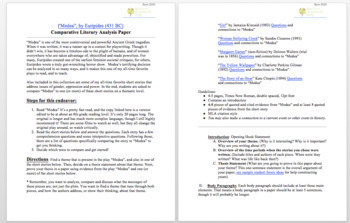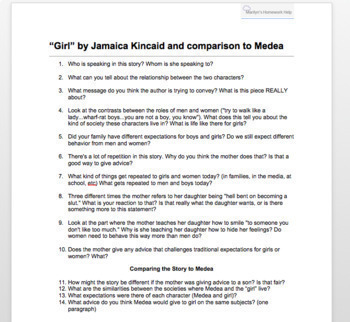Medea, by Euripides: A Compare/Contrast Unit Using the Play and Short Stories
- Google Docs™

Description
Compare and Contrast "Medea" and Assorted Short Stories:
A thematic assignment that will get students thinking about power, gender, revenge, justice, sanity and strength.
Have students read a revised, translated version of the ancient Greek play "Medea" and compare it to a powerful short story for a unique and edgy compare/contrast essay assignment.
This take-home distance learning assignment is the perfect blend of rigor, intrigue, accessibility, gender studies and, oh ya, murder. I've been an ELA teacher for 14 years and these are some of my FAVORITE written pieces all in one place. All female authors. All amazing twisty-turny stories. Distance learning is a time for juicy, engaging and power-punch writing, and this is it!
Included:
- Revised and edited text of "Medea" (reading level appropriate for 8-12th grade)
- Five POWERHOUSE Short Stories of women backed into a corner (with lots of twists!). For each story, there are questions on the story itself included, plus questions that guide the student to make connections to "Medea".
- “Girl” by Jamaica Kincaid, plus comprehension questions
- “Woman Hollering Creek” by Sandra Cisneros, plus comprehension questions
- “Margaret Garner” (non-fiction) by Delores Walters (trial was in 1856), plus comprehension questions
- “The Yellow Wallpaper” by Charlotte Perkins Gilman, plus comprehension questions
- “The Story of an Hour” Kate Chopin, plus comprehension questions
- Compare Contrast Essay Assignment
- Sample Outline
- Sample Student Thesis Statements (from my real life students!)
- Rubric
- All Texts Included
More about Medea (and a warning!):
“Medea” is one of the most controversial and powerful Ancient Greek tragedies. When it was written, it was a runner up in a contest for playwriting. Though it didn’t win, it has become a timeless ode to the plight of humans, and of women everywhere who fight back after being taken advantage of, objectified and made powerless. For many, Euripides created one of the earliest feminist societal critiques; for others, Euripides wrote a truly gut-wrenching horror show. Medea’s terrifying decision can be analyzed in so many ways, and it makes this one of my all-time favorite plays to read, and to teach.
Also included in this collection are some of my all-time favorite short stories that address issues of gender, oppression and power. In the end, students are asked to compare “Medea” to one (or more) of these short stories on a thematic level.
*Warning: Though the play is adapted to an 8th grade reading level, it will not be appropriate for middle schoolers. Please preview the materials.





